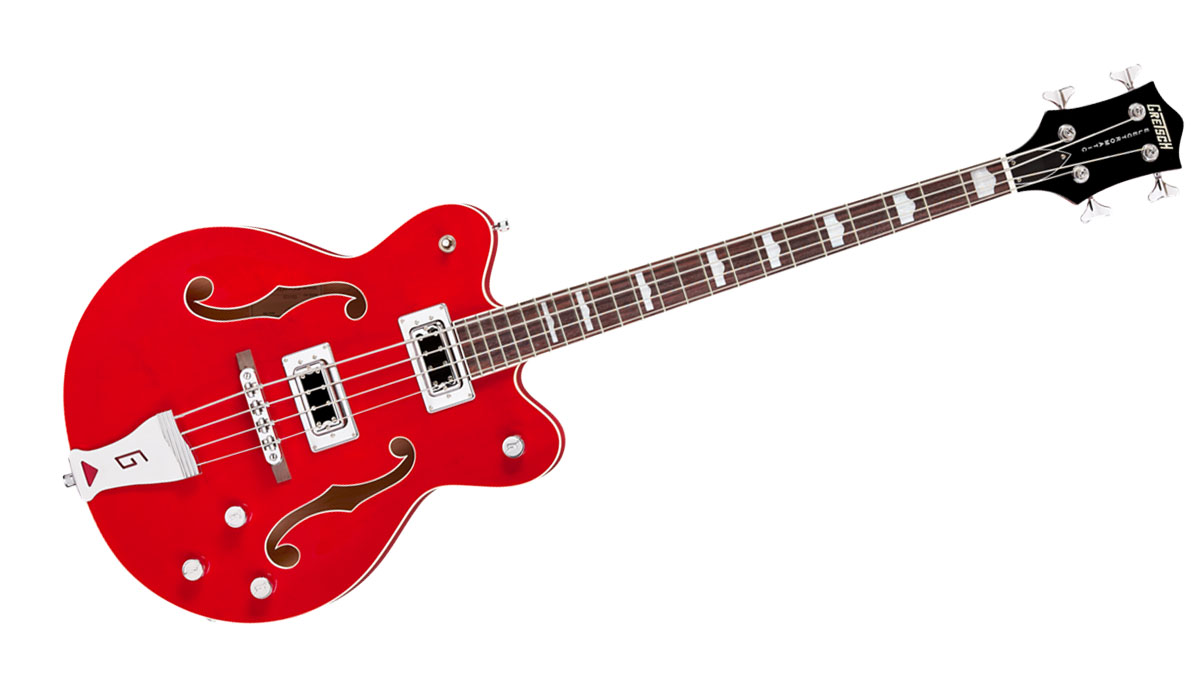Guitar World Verdict
There’s no better bass if you’re after this look and sound.
Pros
- +
Attention to detail.
- +
Authentic sounds.
Cons
- -
Big body.
- -
Headstock dive.
You can trust Guitar World
Gretsch guitars are famous worldwide – who hasn’t lusted over a White Falcon in their time? – but the veteran American brand’s basses are less well known. Still, that’s no reason not to investigate this muscle car of a four-string, the Electromatic, which will supply you with the feel, look, and sound of a '70s bass in return for a nice chunk of your taxed income. So what do you get for your bucks?
Build Quality
With this big a body, the Electromatic isn’t exactly easy to swing around, but find a comfortable position and you’ll be fine. This may take a moment, as this authentically old design also comes with authentically old neck-dive, presumably thanks to its hollow body and weighty headstock. They didn’t complain about that back in ’68, though, so deal with it.
Look down and the landscape is a little different to the regular P or J terrain. The bridge, a massive two-piece unit, takes up most of your view, and you’ll see a master volume on the lower bout and a three-position pickup switch on the upper one. F-holes are there too, although they don’t get in the way as such, and there’s some fancy chrome detailing on the G-Arrow pots and the bridge. It’s all very vintage, but with modern attention to detail, you’ll be relieved to hear, with no sharp fret ends, screws falling out, cheap pickup housings or whatever to worry about.
Still, having played with quite a few ‘overly refreshed’ musicians over the years, I sometimes worry that hollow-bodied basses such as this one might not withstand the rigors of the dressing-room and tour bus quite as well as their solid-bodied equivalents would. Just a thought.

Sounds and Playability
Breathy, throaty, muffled – all the usual adjectives apply when you play this bass unplugged. Those F-holes don’t let much volume out, but there’s enough so that you can hear yourself if you just want to tune up or figure out a bass part.
The fun really starts when you plug in, because the tone range is rather wider than most of us would assume. We’re given three pickup settings – one, the other or both – as well as a master tone and separate volumes per pickup. You’ll no doubt find what you need in there somewhere, from a punchy, modern sound with a bit of edge to a treble-free thud, although true tone extremes aren’t to be found here for obvious reasons.
Hot tip: grab a pick for a clicky Motown tone, although be warned – if you drop said pick inside an F-hole, it’s never coming out again.
The playability is adequate rather than astounding, but then a high-speed platform for your playing was never what this bass was intended to be. Instead, it plays solidly, reliably, and comfortably. The frets aren’t even marked above 17, giving you a clear indication of what its designers intended.
Conclusion
This is a large bass with lots of details, so if you’re looking for an effortless instrument that will be simple to operate while you do something else, like singing for example, you might want to look further afield. If you’re after this particular aesthetic, though, you won’t find it delivered this vividly anywhere else. This bass is a lot of fun, rocker.
Specs
- PRICE: $999.99 street
- MADE IN: Korea
- BODY: Maple
- NECK: Maple, 30.25” scale
- NECK JOINT: Bolt-on
- FRETBOARD: Rosewood
- FRETS: 22
- PICKUPS: 2 x Black Top FilterTron humbuckers
- CONTROLS: 2 x pickup volumes, tone, pickup switch, master volume Hardware | Die-cast tuners, Adjusto-Matic bridge, G-cutout tailpiece
- WEIGHT: 6 lbs
- LEFT-HANDED OPTION AVAILABLE: No
- CASE/GIG-BAG INCLUDED: Yes, at extra cost
- CONTACT: Gretsch
Joel McIver was the Editor of Bass Player magazine from 2018 to 2022, having spent six years before that editing Bass Guitar magazine. A journalist with 25 years' experience in the music field, he's also the author of 35 books, a couple of bestsellers among them. He regularly appears on podcasts, radio and TV.
“It holds its own purely as a playable guitar. It’s really cool for the traveling musician – you can bring it on a flight and it fits beneath the seat”: Why Steve Stevens put his name to a foldable guitar
“Finely tuned instruments with effortless playability and one of the best vibratos there is”: PRS Standard 24 Satin and S2 Standard 24 Satin review












